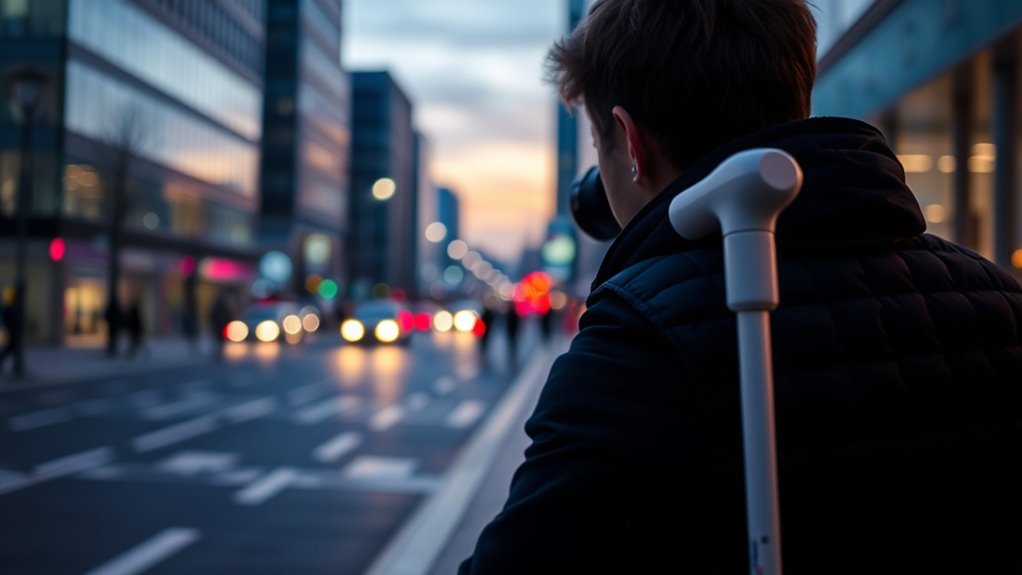To navigate cities without sight or sound, you can rely on GPS apps with voice guidance, tactile maps, and 3D models that help build mental maps. Wearable devices like smart wristbands provide haptic feedback to alert you about obstacles or stops. Voice assistants and community platforms offer real-time guidance and support, while advanced smart canes detect hazards instantly. Stay tuned to discover how these innovative tools work together to keep you safe and independent on the streets.
Key Takeaways
- GPS-enabled navigation apps with voice guidance help visually and hearing-impaired users find their way safely.
- Wearable tactile devices provide real-time obstacle alerts through vibrations and sensory cues.
- Tactile maps and 3D city models assist users in building mental maps of unfamiliar urban environments.
- Voice-activated assistants offer instant guidance and city updates without manual interaction.
- Smart infrastructure with adaptive signals and tactile paving enhances accessibility for all urban travelers.
GPS and Navigation Apps for Independence
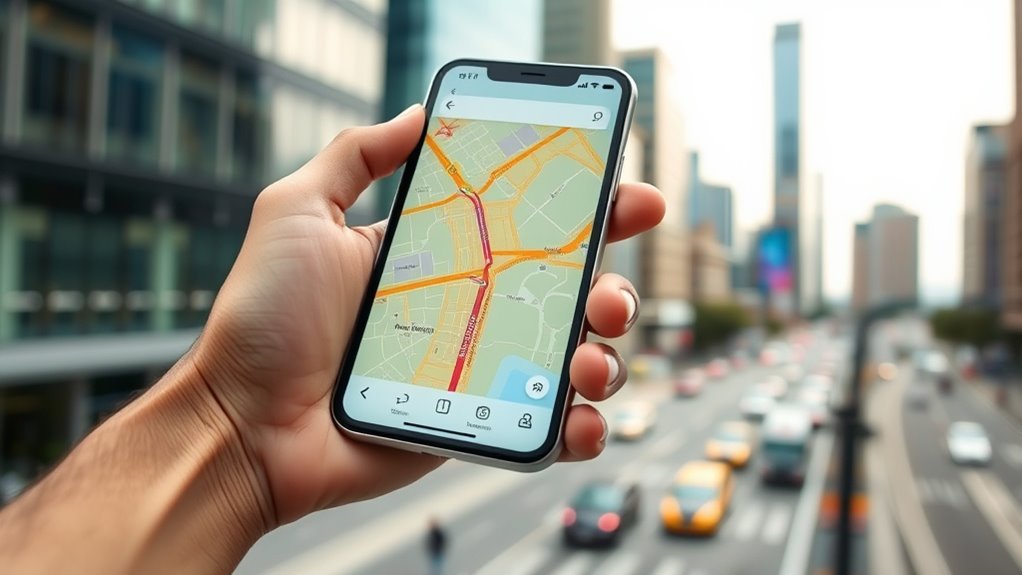
Thanks to advances in technology, GPS and navigation apps have become essential tools that help visually and hearing-impaired individuals navigate cities more independently. These tools are supported by thoughtful urban planning and forward-looking policy initiatives that prioritize accessibility. Cities now incorporate tactile paving, audible signals, and clear signage, making navigation easier with the help of GPS. Navigation apps leverage detailed mapping data, real-time updates, and voice guidance to inform your movements precisely. Policy initiatives promote standardization and integration of these technologies into public infrastructure, ensuring everyone benefits. As a result, you can confidently explore urban environments, knowing that these innovative solutions are designed to enhance your independence and safety while aligning with broader city planning efforts. Additionally, the development of adaptive technologies continues to improve the overall experience for users with sensory impairments.
Wearable Devices for Sensory Feedback

Building on the support provided by GPS and navigation apps, wearable devices for sensory feedback give you an extra layer of guidance. These devices use tactile signals, vibrations, or other sensory cues to alert you to obstacles, changes in terrain, or directions. For example, a wristband or vest can transmit patterns of vibrations to indicate when you’re approaching a curb or crossing. They work seamlessly with your existing navigation tools, providing real-time, intuitive feedback without requiring visual or auditory input. Wearable devices are discreet, easy to wear, and customizable to suit your preferences. By translating environmental information into sensory feedback, they help you navigate confidently and safely through busy city streets, reducing anxiety and increasing independence.
Voice-Activated Assistants in Urban Environments
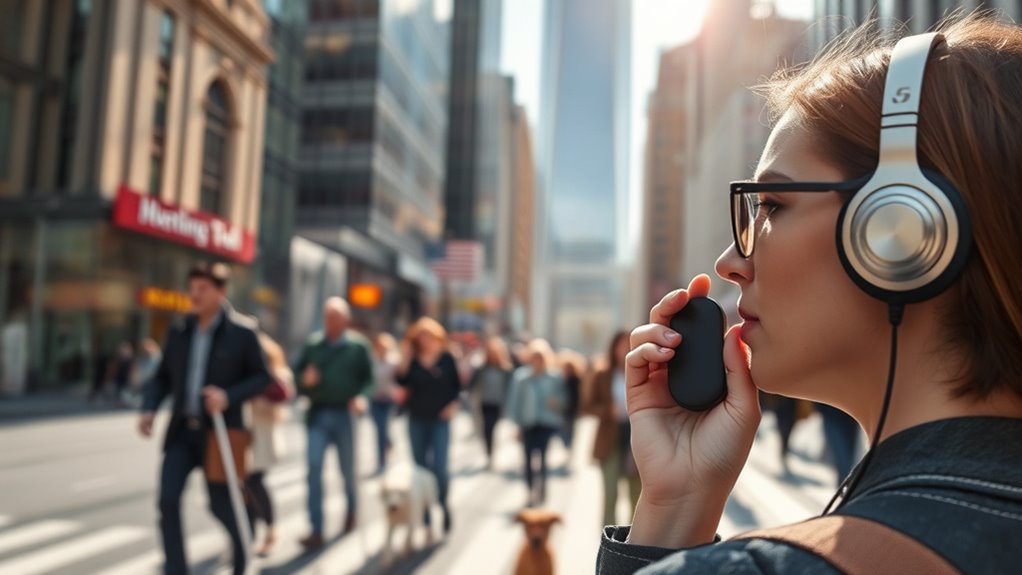
Voice-activated assistants have become essential tools for steering busy urban environments, offering real-time guidance through simple voice commands. When you need directions, simply ask your assistant, and it provides immediate updates, avoiding the need for physical maps or screens. In noisy cities, these assistants are designed to understand your voice commands accurately, even amid background sounds. They can help you find nearby landmarks, transit options, or safe crossing points without stopping or searching manually. Many urban-focused voice assistants are integrated with city services, alerting you to closures or congestion. Additionally, ongoing AI safety measures are crucial to ensure these systems function reliably and securely. By leveraging voice-activated assistants, you gain independence and confidence orienteering unfamiliar streets, making your city experience smoother and safer without relying on sight or sound.
Tactile Maps and 3D City Models
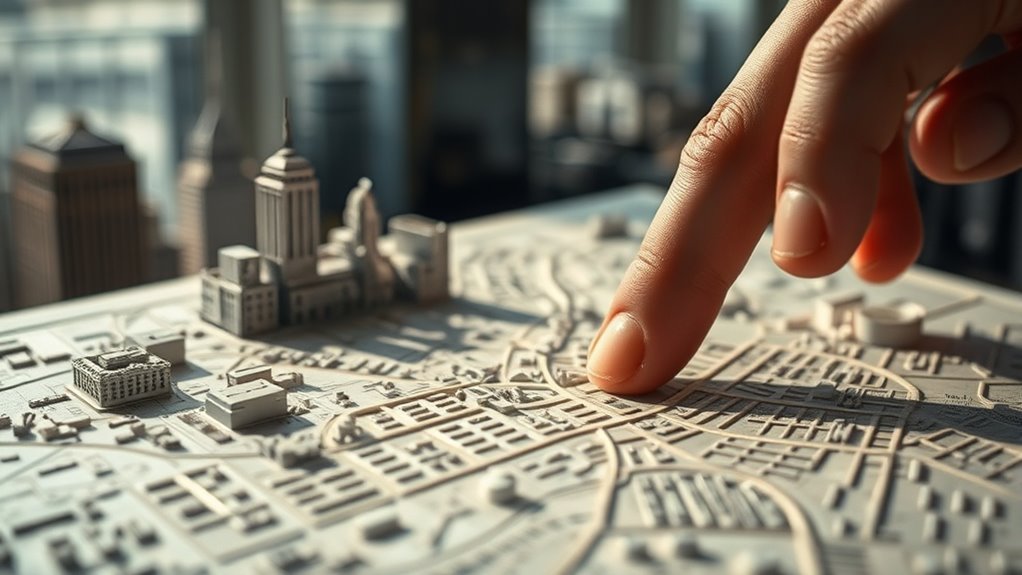
While maneuvering a city without sight or sound can be challenging, tactile maps and 3D city models offer effective solutions. Tactile maps let you feel the layout of streets, landmarks, and public spaces, giving you a tangible understanding of your environment. These maps are often made with raised lines and textures to distinguish different features. 3D city models go a step further by providing detailed, three-dimensional representations of urban areas. You can explore the shapes of buildings, parks, and bridges through touch, helping you build mental maps of the city. Both tactile maps and 3D city models enhance spatial awareness and independence, allowing you to navigate more confidently. They serve as essential tools for bridging sensory gaps, making urban environments more accessible. Additionally, incorporating familiar home-like elements can improve comfort and orientation within unfamiliar cityscapes.
Smart Canes With Advanced Sensors
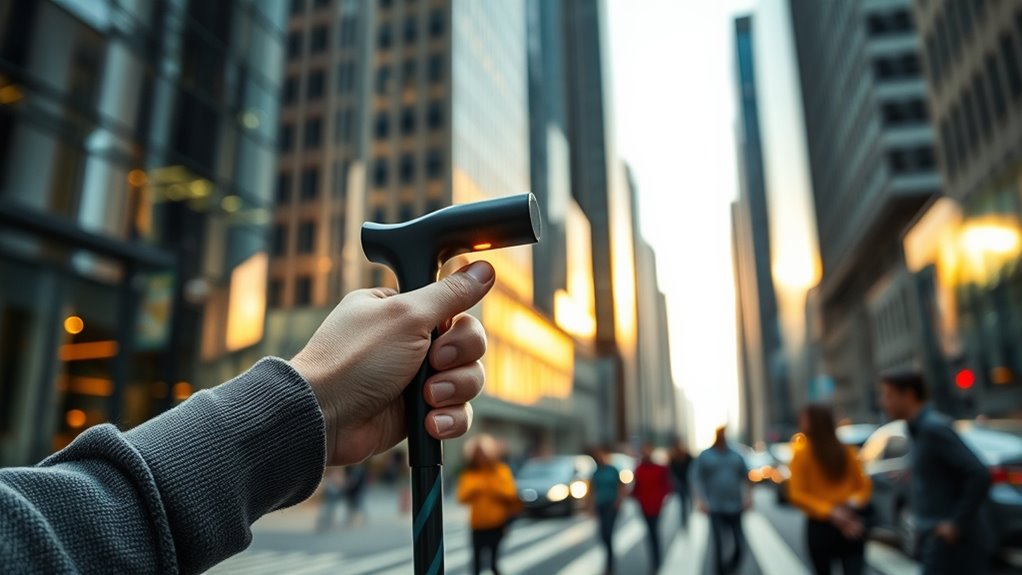
Smart canes with advanced sensors seamlessly integrate technology to enhance your navigation. They detect obstacles and hazards in real time, alerting you instantly to potential dangers. This combination of sensors and alerts helps you move more confidently through busy city streets. Additionally, understanding electric dirt bike capabilities and features can inspire alternative mobility options for independent travel.
Smart Canes Sensors Integration
Advanced sensors are transforming smart canes into essential tools for navigation by providing real-time, precise environmental data. These sensors detect obstacles and environmental changes, allowing the cane to relay critical information through haptic feedback. When you approach an obstacle, the cane vibrates differently depending on proximity, giving you intuitive cues for obstacle avoidance. Seamless integration of sensors ensures the cane can interpret complex surroundings, helping you navigate crowded streets and tight spaces safely. This integration minimizes surprises and enhances confidence, making your journeys smoother. By combining advanced sensing technology with immediate tactile alerts, smart canes empower you to move independently and securely, reducing risks and improving overall mobility in challenging urban environments. Additionally, understanding how to interpret environmental cues can further improve navigation and safety.
Real-Time Hazard Detection
Real-time hazard detection has become a game-changer in smart cane technology, allowing you to respond instantly to your surroundings. Advanced sensors continuously scan your environment for obstacles, enabling effective obstacle detection. When the cane detects a potential hazard, it alerts you through vibrations or audio cues, helping you navigate safely. This feature enhances collision avoidance, reducing the risk of accidents in busy or unfamiliar areas. With real-time updates, you can make immediate adjustments to your path, feeling more confident and independent. The integration of advanced sensors ensures that you’re aware of both stationary and moving obstacles, giving you a smarter, more responsive tool for city navigation. Incorporating mindfulness practices, such as focused awareness and breathing techniques, can further improve your ability to stay present and alert while navigating challenging environments. This technology truly transforms how you experience your environment, making mobility safer and more reliable.
Public Transport Accessibility Technologies
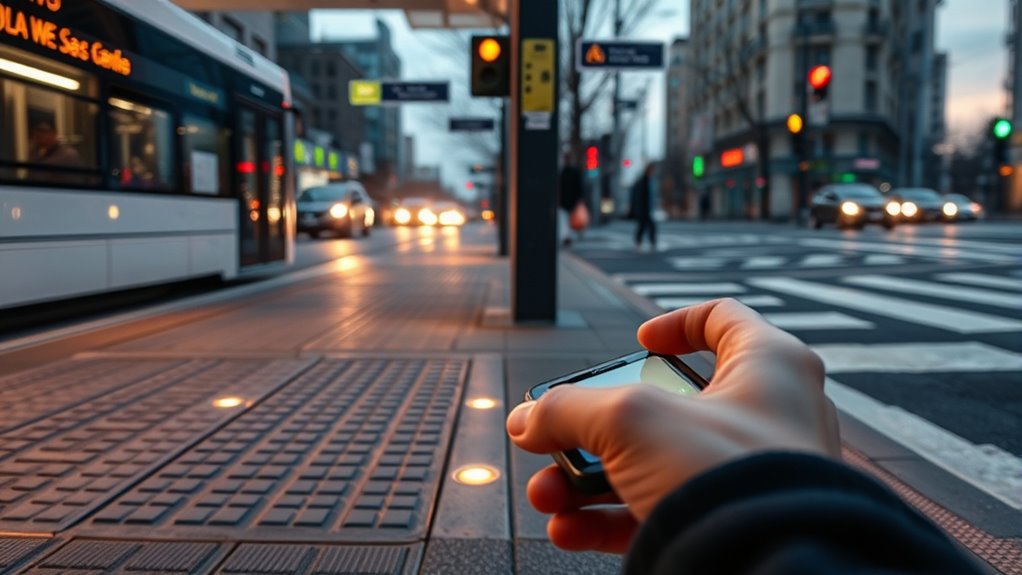
Public transport systems now offer real-time transit alerts that keep you informed about delays and arrivals. Tactile navigation aids help you move confidently through stations by providing physical cues. These technologies work together to make urban travel safer and more accessible for everyone. Incorporating indoor air quality considerations in station environments can further enhance passenger comfort and health.
Real-Time Transit Alerts
When using public transportation without sight or sound, staying informed about transit status is essential, and real-time transit alerts make this possible. These alerts provide timely updates on delays, arrivals, and route changes, helping you navigate urban noise and rely less on visual cues. They can come through vibrations, spoken notifications, or app alerts, keeping you confident and independent. Essential for maintaining awareness during your journey.
- Feel secure knowing you’re always updated, even amid busy city sounds
- Reduce anxiety about missing your stop or sudden delays
- Experience the freedom to travel confidently, regardless of visual distractions
- Stay connected with real-time information tailored to your journey
- Embrace urban travel with less stress, more control, and peace of mind
Tactile Navigation Aids
Tactile navigation aids play a crucial role in helping you move confidently through public transportation systems. Vibration feedback alerts you to important information, like approaching stations or changes in stops, giving you a reliable sensory cue. Textured overlays on signs, buttons, and pathways provide tactile differentiation, making it easier to identify key areas or features without needing sight. These overlays can be used on ticket machines, platform edges, and fare gates, helping you navigate safely and efficiently. By integrating vibration feedback with textured overlays, transit systems enhance accessibility, reducing reliance on auditory or visual cues. Incorporating dream symbols into understanding these tools can offer insights into your subconscious perceptions of independence and safety, further empowering your travel experience. This combination empowers you to travel more independently, ensuring smoother, safer journeys through busy city environments.
Community and Support Networks Powered by Technology

Technology has revolutionized how individuals who are blind or deaf build and maintain community and support networks. You now have access to platforms that foster community engagement and peer mentorship, breaking down barriers of isolation. These tools allow you to connect instantly with others who share your experiences, offering crucial emotional support. Imagine sharing your journey, receiving advice, or simply feeling understood—without geographic limits. You can participate in online forums, virtual meetups, and mentorship programs that empower you. These networks provide a sense of belonging and strength, reminding you that you’re not alone. Privacy policies ensure that your personal information is protected as you engage with these communities.
Technology connects individuals who are blind or deaf, offering support, community, and empowerment beyond physical boundaries.
- Find encouragement from others who truly get your struggles and triumphs
- Share your story and inspire someone else’s journey
- Access real-time support during challenging moments
- Build lifelong friendships beyond physical boundaries
- Feel empowered through shared experiences
Future Innovations in Urban Accessibility

Innovations in urban accessibility aim to make city life more navigable for individuals who are blind or deaf, building on the support networks enabled by technology. Future developments will likely involve smarter urban planning that integrates accessibility features directly into city infrastructure, such as tactile paving and audio-visual signals. Policy development will play a vital role in ensuring these innovations are standardized and widely implemented. Expect advancements in AI-powered navigation tools, real-time environmental alerts, and adaptive street furniture designed to respond to diverse needs. These innovations will foster more inclusive environments, empowering you to move confidently through urban spaces. By prioritizing accessibility in policy and planning, cities can become more equitable, ensuring everyone benefits from the evolving technological landscape.
Frequently Asked Questions
How Do These Technologies Integrate to Improve Overall City Navigation?
These technologies work together by enhancing urban infrastructure with smart sensors and connectivity, making navigation smoother for everyone. Assistive app integration allows you to access real-time data on accessibility features, obstacles, and routes. As you move through the city, these tools provide seamless guidance, helping you avoid hazards and navigate efficiently. This integration creates a more inclusive environment, ensuring you can explore urban spaces confidently and independently.
Are There Privacy Concerns With Using Wearable and Tracking Devices?
You might wonder if wearable and tracking devices raise privacy concerns. While these devices enhance navigation, they also collect data that could threaten your personal privacy. It’s essential to confirm data security measures are in place to protect your information. Be aware of how your data is used and shared. By understanding these risks, you can take steps to safeguard your personal privacy while benefiting from the technology.
What Training Is Available for New Users of These Assistive Technologies?
Think of learning to use these assistive technologies as beginning on a new adventure. You’ll find training programs and user workshops act as your guides, helping you master the tools. These sessions cover everything from basic setup to advanced techniques, ensuring you’re confident exploring the city independently. With dedicated instruction, you’ll gain skills quickly, making your journey smoother and more empowering every step of the way.
How Affordable Are These Advanced Navigation Tools for Most Users?
When you ask about affordability, you’ll find that the cost comparison varies widely across advanced navigation tools. Many options now offer affordability options, like subsidies, grants, or low-cost devices for users with disabilities. Some mainstream apps integrate assistive features at little to no extra cost. While some specialized equipment can be pricey, exploring these options helps you discover solutions that fit your budget and guarantee safe city navigation.
Can These Technologies Adapt to Different Urban Environments Worldwide?
You’ll find that these navigation technologies are continually improving their cultural adaptability and infrastructure compatibility worldwide. Developers design them to account for diverse signage, language differences, and varying urban layouts. While some challenges remain, ongoing updates and user feedback help these tools become more versatile across different environments. Ultimately, this guarantees you can navigate unfamiliar cities confidently, regardless of local customs or infrastructure variations, making your experience safer and more efficient.
Conclusion
With these groundbreaking technologies, you could navigate a bustling city blindfolded—better than most sighted people! From smart canes to 3D maps, every device is like having a personal guide whispering secrets of the urban jungle. Soon, you’ll explore streets and skyscrapers with ease, feeling unstoppable. The future of city navigation isn’t just bright; it’s a revolution so powerful, it’ll blow your mind and redefine independence forever!

